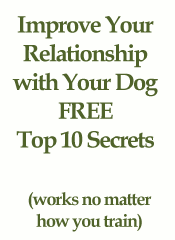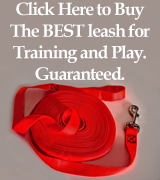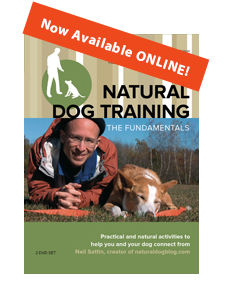Ever since the rise in Cesar Milan’s (“the dog whisperer”) popularity, the mantra among dog owners (and some dog trainers) has been “calm and assertive, calm and assertive, I must be calm and assertive”. The problem is that not many people actually know what that means in terms of how to act with their dogs, and in terms of dog training. Also, since Cesar talks constantly about being the “alpha” dog, most people seem to fall back on their ideas about what it means to be the “alpha” when they’re trying to be calm and assertive. I am here to give you a NEW metaphor for “calm and assertive” – don’t be the alpha dog, be the MOOSE in your dog’s life.

Calm…assertive…moose? You’re probably thinking that I’m a little crazy. Well, maybe not - if you’re here reading you're at least curious about how natural dog training works, and what it means to use the prey instinct to resolve problem behaviors in dogs and elicit obedience behaviors. In the end, I think that you’ll find that “being the moose” will be a much more effective way for you to envision yourself around your dog, especially as you engage in training AND play exercises. Also, once we start to talk about resolving problem behaviors in our dogs, you’ll see that there’s no other way to be.
Now…why a moose? Why can’t I be something more graceful, like a gazelle? Or nimble, like a jackrabbit? A few reasons:
- A moose is a high value prey animal. The more effort that a dog (or pack of dogs) would expend on the hunt, the more satisfied they’ll be at the end of the hunt, and the “higher value” that prey animal becomes. When your dog catches that jackrabbit, the whole process will have required less effort, satisfied less internal stress, and, ultimately, only offer a momentary fullness in the belly.
- A moose also is big, powerful, and, if it’s staring you down, it has lots of PREDATOR energy as well. Think about it…you’re walking through the woods, and you come upon a moose. The moose is taller than you, weighs 10x as much as you, and is facing you, staring at you intently. You stop, and you wait. The moose keeps staring at you, and lowers its head. Snorts a couple of times. Then it starts taking steps in your direction. Tell me that you’re not going to head for the nearest tree!
- The moose also has characteristics that will be helpful for you, as you imagine yourself to “be” one. The moose is strong. The moose is rooted firmly on the ground – you couldn’t push a moose over. A moose can be nimble when it has to be nimble, but it can also be a frightening adversary if confronted.
So imagine that your dog and a group of friends are hanging out, sniffing their way through the woods. They come to a clearing, and there, in the middle of the field, is a big moose. Slowly the dogs approach from the side, fanning out, and getting ready to make the kill (if your dog is a yorkie terrier this is where the story might start to amuse you, but please, bear with me). The moose senses their presence and feels the energy of their approach, and at this point fight or flight takes over, and the path of least resistance is to flee. The moose runs, and the dogs take off in pursuit. At this point, some of the dogs will attempt to flank the moose. They’ll be running along, trying to get right next to the moose (herding behavior). Meanwhile, they come to a rise, and the moose, feeling perhaps more desperate, quickly turns to face down the attackers. The dogs scatter, circle back around, and hit the dirt (laying down), waiting to see what’s going to happen.
Now the moose actually has the upper hand, and if the moose actually threatens the dogs by approaching them, they will probably, eventually, give up. If the moose were to turn and run again, it would likely be only a matter of time before the moose, exhausted, meets an untimely end. OK, enough of the story.
Take a moment and breathe, make sure that you’re still with me. Did you notice anything about that scenario, anything strange? The MOOSE was actually the one in control of what was going to happen. The moose runs, the dogs chase. Some dogs even try to run right up next to the moose…they’re HEELING! The moose turns and faces down the attackers, and the dogs lay DOWN in anticipation. The dogs are completely in synch with the moose, responding to whatever the moose decides to do. Their behavior revolves completely around the moose’s actions. Now, if only the moose understood that! Maybe it does…
Another important thing for you to get is that the dogs “know” what to do automatically. The alpha dog isn’t barking out orders, but the relationships between the dogs have some bearing on how they fan out to surround the moose. So, basically, the dogs are acting in complete harmony with each other, intuitively, to accomplish a specific purpose, the purpose that they were born to fulfill. This is the natural dog training definition of SOCIAL behavior. Those dogs are way more attracted to that moose than they are attracted to each other.
Let’s think about it in human terms for a moment. You have a smallish backyard, and it’s fenced in. Your child is having a birthday party, so a dozen children arrive at your house, all looking for something to do. You send them all out into the backyard, because you haven’t finished baking the cake yet. The only thing is, there’s nothing for them to do in the backyard. It’s empty. No swingset, no sandbox, no tireswing…nothing. How long do you think it’ll take for someone to start teasing someone else, or someone starts crying, or…? Not long, I’ll wager. That’s PACK behavior. It’s what happens when a bunch of people are hanging around without anything better to do.
Same situation, only there’s a jungle gym outside. A big jungle gym, with enough activity stations for everyone. Think you’ll have a problem now? It’s much less likely, as the children’s behavior will revolve around the jungle gym. They have a common purpose, playing on the jungle gym. The kids might even work out a way to take turns on the teeter-totter (do they even come with teeter-totters any more?). Sound familiar? That’s social behavior, and in this instance the jungle gym is like…you guessed it…the moose! And those children are way more attracted to that jungle gym than they are attracted to each other.
Let me offer an additional point, something that I’m hoping will be obvious to you. It’s not that your dog will want to eat you, like they want to eat the moose.
The whole idea is that by being like the moose you will:
- Be the most attractive thing in the universe to your dog. Nothing is more appealing to your dog than the moose.
- Engage your dog’s naturally SOCIAL instincts (along with obedience behaviors). All of your dog’s behavior will revolve around you, and your dog will, eventually, look to you to resolve the FEELING that they get of wanting to “make prey” – on bike riders, other dogs, the neighbors children, squirrels, etc.
- Develop facility with prey AND predator energy. The predator energy is what zaps your dog into action – it’s what stirs up the stress inside them, gets the motor revving. The prey energy is what allows your dog to resolve that stress, giving them an outlet for all of the potential revving up inside of them.
- Most importantly, by “being the moose” you will also be able to break some of your habits, habits that you didn’t even know you had, but which are associated with “being the alpha”, and which might, ultimately, be unproductive in your relationship with your dog. Being the moose allows you to see the world through a different lens, and you will start to notice different things about your dog’s behavior, developing different, more productive patterns of interacting with your dog.
One more important thing. As humans, we already possess lots of “predator” energy in our dog’s eyes. We walk upright, we have big hands, big eyes, big teeth (which we like to show off). Throw in a few other things that people like to do, like making eye contact, chasing your dog – heck, even things as subtle as approaching your dog with your hand out palm down (your hands are like the talons of the eagle descending upon your dog’s head – palm UP is much easier for them to take) – and it’s a wonder that our dogs are attracted to us at all!
So you want to focus your time on developing more of that prey energy. That’s another reason why “being the moose” is so important. You need to become a high-value prey object in your dog’s life! Practice things like:
- During play, encourage your dog to chase you. Entice them with a tug toy. When they get to you:
- Play tug of war with your dog and LET THEM WIN.
- When you want to get your dog to COME to you, do that by…yep, encouraging them to chase you. Move away from them instead of moving toward them. Also, keep the energy level down…as in, don’t get all hyped up if they’re not coming your way.
- Notice the difference between standing sideways to your dog and facing your dog - the first is much more prey-like, the second...predator. There are times when each is appropriate, but you need to become aware of the differences that each produces in your dog's behavior.
- If you’re looking for ways of “kissing” your dog, just give them gentle massage to the chest, back, and sides. Think of it as your mission to relax your dog as much as possible (we’ll talk about that some more in a later article). Don’t actually kiss your dog, face-to-face interaction is very confrontational (predator) in dog world.
- Instead of feeding your dog from their bowl for every meal, choose a meal and feed your dog by hand…OUTSIDE. Give them some food, then move away a few steps and let them come to you for more food. It’ll probably be helpful to have a feed pouch (I use an old LL Bean fanny pack).
- Practice smooth, gentle, rounded motion when you’re interacting with your dog. Bunnies bound away (prey energy), while tigers stalk toward you (predator).
Also, please read my article on pushing, a fundamental natural dog training technique that will help your dog be even more attracted to you.
In general, what you want to do is foster some of that calm, assertive MOOSE energy. Breathe. Use your newfound quietude to observe what your dog does, and ask yourself, frequently, if what you're doing is making your dog more attracted to you or less attracted to you. Ultimately, the explanations matter less than the actions, and it all boils down to the results. In dog training, it’s important to slow down, relax, and, more than anything else – pay attention. If what you’re doing isn’t working the way you want it to, try on a different perspective…one more “moose-like”.
When I watch Cesar Milan work, I often think that he’s actually being a lot more moose-like than alpha-dog-like. Maybe he couches everything he does in the language of “alpha” because that’s easier, in some ways, for people to understand, despite recognizing that something else is at work? Or maybe he really believes that he IS being the alpha dog? Perhaps one of these days I’ll meet Cesar (in fact, he’s good friends with the aunt of a friend of mine, so I might actually get that chance at some point), and we’ll be able to talk “dog” with each other. I better work some more on my alpha roll. 🙂
(just kidding - no alpha rolls here)
As always, let me know if you have any questions, and thanks for stopping by!





Neil, I need time to let this roll around for a bit, some of my questions might be irrelevant once I've had some time to sit with it. Thanks for the food for thought!
Sure thing! FYI, I made a few edits in the "Practice things like:" list for clarity.
Neil, I'm reading this for the third time after considering it for a few days, and having some fresh dog experiences in my mind. Here are my questions:
Is it possible to use the prey/predator interpretation to help a dog relax in a potentially uncomfortable situation for them?
For example, a dog that is uncomfortable meeting new people who use confrontational body language is approached by someone that uses too much eye contact or approaches too directly. Can I interject something in the developing dynamic to diffuse the situation (other than instructing the other person to change their approach or removing the dog).
My "new" dog Stevie is high energy, perpetual motion and constantly barging into other creatures and their space. The fastest way to get his attention when he is winding up is to take his space by stepping in it. He will almost immediately calm down and become attentive if it is done without eye contact or acknowledgment of his presence. I think i just answered my own question by typing that out, but how do you see this fitting in with the predator/prey model? Can you offer some words on how to consider space and what it means to the interactions we have?
Hope all that made sense. Thanks.
Hi Angelique -
The answer to your first question is a most emphatic YES!
I plan to write a new post to address the two specific examples you mention, as they'll take more than a comment. However, as to the "why", here's the quick explanation:
1. Think of stress in a dog as stored up energy. Their chief mechanism for resolving that stored up energy is by "making prey".
2. So when a dog is in an intense situation, if you have done enough preliminary work (something I will definitely cover in its own post) so as to "insert" yourself in the "I'm feeling charged up and so now I need to DO something with this energy" circuit, then your dog will look to YOU as an outlet for releasing that energy (in a positive way) instead of following the path of least resistance (which would be finding something even more "prey-like" than you). Part of "becoming the moose" is to overcome your dog's resistance to interacting with YOU in high energy situations.
3. HOWEVER, a dog needs to be physically relaxed in order to have a healthy "flow" of this energy. If your dog tenses up, then you are much more likely to see a "rapid discharge" of the energy - something like "aggressive" behavior or submissive peeing (this probably applies more to situation #1).
I've often described to clients, especially those with "opportunity" dogs (see the next post for that reference), that what we're really trying to do is help our dogs relax at higher and higher levels of stimulation. A relaxed dog feels safe, and the faster the motor gets revving the more rooted/relaxed they'll be. A non-relaxed dog - well, like I said before, they can only take so much before the dam bursts. If you answer the question for your dog of "what do I do with my energy?" then whenever they feel energized they will look to you for the answer. At least they'll look at you first! And it's not a mental choice, it's more like a "pattern of feeling" that they learn.
And, as we talked about in another thread, of course it's equally as important that the owner can stay relaxed in these situations as well.
I'm working on some video for my first "lesson" - which is a technique called "pushing" that is a great fundamental way to insert yourself into the circuit. Tug of war, if your dog knows how to play it "on command", is another way.
Thanks for such great questions. They really merit their own posts, so...stay tuned!
I was fascinated by the "moose" theory. I have been to so may dog sites, many totally contradictory, and have also had a trainer for my rescue lurcher who I have had for two months and frankly a cheery voice, jumping up and down, dispensing treats has not done it for him - or for me. I have not yet taken this in fully but I will. I had him on the beach today and he was running like mad. The thing that makes him come back to me is when I start going in the opposite direction - that far more than treats.